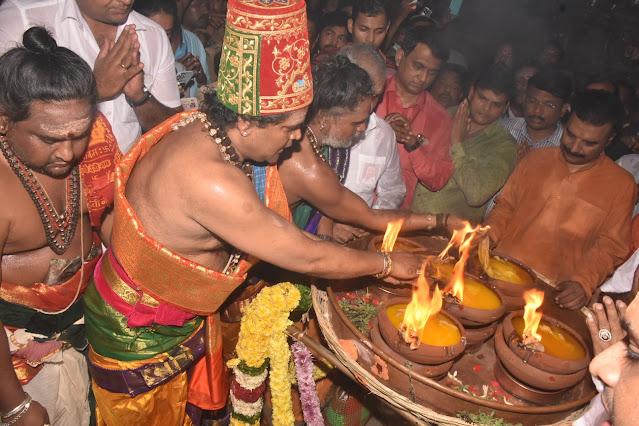I have made many posting about Sri Siva Jothi Mona Siddhar on my Arunachala Mystic blog, to read these posts and for information about him and his interaction with devotees check out the links on the left column of this Blog.
 |
| Sri Siva Jothi Mona Siddhar Swami |
Swamiji's ashram is located off Vettavalam Road about 20 kms from Arunachala but due to winding country lanes is about a 30 km drive from Tiruvannamalai. An ever-increasing number of devotees and pilgrims visit Swamiji at his Ashram to consult with him and receive his blessings. As a result of strenuous tapas Swamiji received siddhis from the Divine that have given him the ability to understand, guide and support those in distress—and also to perform healings.
 |
| Sethavarai countryside near Ashram |
Swami's Sadhana
Swami was born on October 3rd, 1962 and named Sri Narayanan. He lived a rustic life in a small Tamil village and at 27 years of age agreed to an arranged marriage which resulted in the birth of a girl child. However his yearning for a spiritual life led him to renounce the world and enter into sannyas. He thereupon went into the forest to perform sadhana and continued to roam about for over 15 years. One day desolate at the meaningless of life he decided to commit suicide by jumping from the summit of Kanjanakiri Mount (near Vellore District).
Sri Siva Mona Siddhar was prevented from this act by the call of a sadhu who had seemingly appeared from nowhere. The sadhu invited him to a nearby Temple to eat and sleep and in the middle of the night, the sadhu disappeared. Swami stayed in Kanchangiri Temple’s Ashram, at the back of which was a Kanni Temple and this is the exact spot where he was bestowed Divine powers by Lord Shiva.
Miracle Bestowed Powers
One day, when his body was in a dire condition, and he felt that there was no hope left, he prayed to Mother Unnamulai Ammal, beseeching, “you give food to the whole World, so why can’t you take care of my needs and feed me?”
Immediately on uttering this prayer, five ladies and five men suddenly appeared in a vision and came to Swami and laid him on the floor. The five ladies sat below the head of the prostrate body, and the five men sat above the head. Each of the five ladies started to remove parts of Swami’s body, bit-by-bit, and made up small packages of the body parts.
During this whole process Swami felt absolutely no pain. Finally only his head remained. Thereupon the ladies said, “give these small packages, to those that come to meet you, as prasadam.” After this, the five men sitting above him, placed their hands upon Guruji’s head and after a few moments disappeared. At that very moment Guruji’s body reappeared and from that time till this day, Guruji has not had a single problem with his body.
Merging with a Lingam
Sometime after the incident whilst Swami was in meditation, a Lingam suddenly appeared. In his excitement he tried to lift the Lingam but as it was heavy he wasn’t able to move it even an inch. Upon being unable to move the Lingam, he decided to perform a puja, so stood up in order to perform the ritual; as he stood the Lingam also lifted up to his position, slowly came towards him, and then mingled with him.
It was at this time that he came to an understanding of the truth of life. According to his inner guidance Swamiji travelled to Sethavarai and isolated himself in a cave for 58 days. As a result, he received a vision of the Divine and guidance as to his work in this lifetime. An increasing number of devotees and pilgrims visit Swamiji at his Ashram (which has developed around him) to consult with him and receive his blessings.
Ashram and Temple
Now that there is a Temple at Swami's Ashram some devotees arrange pujas to be performed at that place, in order to further bless their prayers.
 |
| Temple at Swami's Ashram |
 |
| Lord Siva Shrine inside Temple |
Temple Daily Schedule.
Temple Timings: 6 am—12 noon and 3 pm—7 pm
Special Pujas:
New Moon Day, Full Moon Day, Astami Day, Pradosham
Each month special pujas take place at Pradosham (evenings from 4.30 pm—6.00 pm) and at Poornima from 6 am—12 noon. The Poornima puja includes Abhishekam, Fire Homam and Anandam.
Swami Darshan and Interviews
Swami Darshan: 9 am—12 noon (sometimes up to 1 pm). Special Darshan can be arranged for afternoon session. Mondays there is no Swami darshan.
 |
| Swami giving blessings during Interview |
Location and Contact Information:
Sri Siva Jothi Mona Siddhar Dharma Paribalana Trust
Sethavarai, Nallan Pillai Petral Village & Post
Gingee Taluk, Villupuram District, Tamil Nadu
+91 96291 45883 Ashram Manager





























